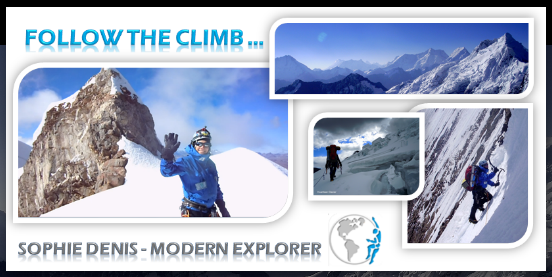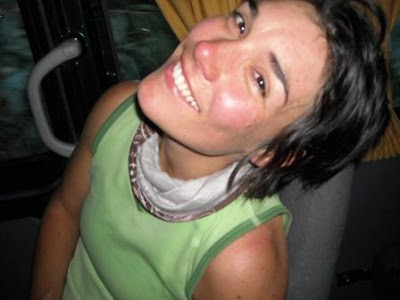Saturday, August 29, 2009
The North East Face of Artesonraju - climb detailed
 Sophie on the way back - Artesonraju
Sophie on the way back - Artesonraju Artesonraju the North East face - the most technical face of Artesonraju
Artesonraju the North East face - the most technical face of Artesonraju 1. The first part of the glacier was steep but the snow with the cold was good and crispy. We passed 2 major line crevasses. It was a good start, we were walking fast.
2. This phase was more delicate as we have to pass few big open crevasses and have to do few traverses.
 Opened crevasse
Opened crevasse3. We are one the first shoulderof Artesonraju. We can relax, and walk fast.
4. Delicate phase to reach the face, we have to pass a field of crevasses, open crevasses and snow bridges. To avoid them we do as much as possible traverse, which is climbing on the icy part of the face in horizontal. Just before to reach the snow cave where we start the face, I fell in a crevasse. I managed to get out of it pretty fast, using my ice axes and my bag pack to not fall deeper in the crevasse.
 Sophie - Traverse climb
Sophie - Traverse climb
 Video : Sophie in the snow storm (video kinda white at the beginning ... sorry...) : http://www.youtube.com/watch?v=3ER4qnTHaI4
Video : Sophie in the snow storm (video kinda white at the beginning ... sorry...) : http://www.youtube.com/watch?v=3ER4qnTHaI4 7. We turned back a pitch away from the summit as the snow condition were terrible. Beto fell 3 times. It was very dangerous because we could not put neither anchors nor protections when climbing, and with high risk of creating avalanches. We could see the top, almost touching it, but it was too dangerous, so we turned back.
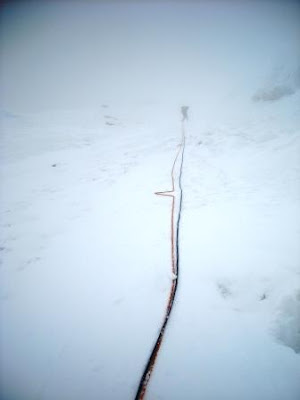
8. On the way back, I was going down first but I could not see anything, so it was so difficult to find the way back. I kept falling in crevasses, 5 crevasses … it is not a big deal to fall in crevasse, as we are trained to rescue. So I was ok with that. But I was so frustrated to not be able to appreciate very well the snow bridges quality of the crevasses. Beto understands so well the glacier dynamic and the glaciology… So I know what is my next step :D
9. We arrive to our camp 1. we fold our tent then we went down straight to our base camp. it was snowing, the ground was wet. We kept sliding.
10. After 2h we arrive to base camp, all our gear was soaked. Even if we did not summit, we celebrate our climb, because in our heart we know that it was a success. We can be happy that we used a good judgment call: risks were too high to summit.

Artsonraru - Day #3

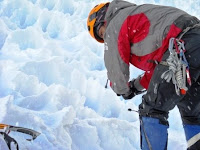
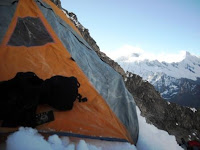

 It snowed all night. Initially we wanted to start at 8:00am, but we decide to wait for better weather. Noon was our dead line, as we need ~5h to camp1.
It snowed all night. Initially we wanted to start at 8:00am, but we decide to wait for better weather. Noon was our dead line, as we need ~5h to camp1. The trek to the moraine is pretty straight forward: mix terrain with mud and loose rocks.
Once we arrived at the bottom of the glacier, we hide our spare food and clothe under some rocks.
Then we start climbing.
We climbed until we could find a safe place to set up our camp. It is pretty cool, because you decide of a camping place in the middle of nowhere, then you dig the snow to make a snow platform to pitch your tent.
We were in our tent at 5pm. We carry some water to avoid to waste too much time melting snow and to save our gas. But unfortunately, boiling water took us forever and we finally eat ~8pm. Because it was so late already, we skipped the soup, and eat crackers, cheese and noodle soup.



Artsonraru - Day #2


Artsonraru - Day #1
Monday, August 24, 2009
Artsonraru - a new challenge
Sunday, August 23, 2009
Health - follow up
- Cold: none
- Altitude sickness: none
- Allergy: terrible allergy to mosquito bites. It wakes me up at night ...
- Stomach virus: none
- Weight: Aug. 15th - I gained about 4lb before my trip. It is important to start your climb with some 'fat' easily available. Otherwise you end up eating your muscles to get some energy. It is a little drastic, but that's the idea Aug. 23rd - I am happy, I did manage pretty well my body mass I lost just few pounds. I eat as much as I can to catch up and not loosing too much weight. So hopefully, I will have a decent body mass at the end of my climbing trip.
Aug. 28th - I lost about 8lbs total, so it is not too bad ... I ate about 4 eggs every day to minimize my loss of proteine ...
Summit Day video
http://www.youtube.com/watch?v=sha3he-Ijrc
Video - Sophie climbing the 6th pitch of the face with the smile. Steep icy section. I was feeling great. http://www.youtube.com/watch?v=lNamCLVOY-o
The Crudita Route climb detailed
 Approach:
Approach:
1. Hike on big broken rocks to the glacier We tried to find a way with not too many loose rocks and with as short as possible rock climbing sections. My body always needs a certain time to adjust itself to this effort requested, to the cold, to an intense work out in the middle of night … as result I have often short and heavy breathing the time to find my pace, which I have to say worried a little Beto at first.
2. Put on our crampons then walk on the glacier to the bergshrom Our walk on the glacier was surprisingly good. The snow conditions were pretty good except some parts where you have to kneel down and crawl. That is a good technique to repatriate your weight on the snow and avoid spending too much energy when walking on deep soft snow.
Climb the Face :
3. Pass the Bergshrom The wind on the top of Pisco was very strong and lots of fresh snow was falling on us. To protect us, we hide ourselves in the beginning of the giant crevasse "the Bergshrom". It was a very cozy the time to wait that the snow fall ends. To pass the Bergshrom we have to climb a very difficult section with an angle of 90 degree. Fortunately it was short, but it took many attempts to finally climb this part. What a start!
4. Start climbing the face We climb with one rope of 60m. It was a moderate section with good crispy snow, with an angle ~60 degree. We climbed this section pretty fast.
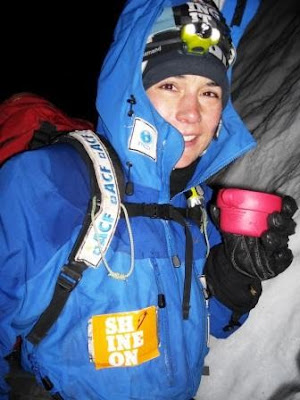 5. Lower middle section on the face
It is a steep section of mix climbs with hard ice and rocks. Angle 75 degree up to 90 degree
5. Lower middle section on the face
It is a steep section of mix climbs with hard ice and rocks. Angle 75 degree up to 90 degree

 6. Upper middle section on the face
I did not enjoy as much this climbing part mainly due to the snow conditions. The issue with soft snow is that we slide down as much as we climb. Moderate angle ~65 degree.
6. Upper middle section on the face
I did not enjoy as much this climbing part mainly due to the snow conditions. The issue with soft snow is that we slide down as much as we climb. Moderate angle ~65 degree.
 7. Final push : first attempt via the canaleta
We wanted to reach the summit by using the canaleta, which from the distance seems doable. But once there, it was impossible and very risky to climb, so we change route, adjusting ourselves to the situation.
7. Final push : first attempt via the canaleta
We wanted to reach the summit by using the canaleta, which from the distance seems doable. But once there, it was impossible and very risky to climb, so we change route, adjusting ourselves to the situation.
 8. Pisco Face traverse
As the canaleta was not open, we traverse the whole Pisco face from left to right. It was pretty exposed, so to avoid creating avalanches, we have to climb as close as possible to the mountain face where the snow is unfortunately the deepest and softest. It was the only way, but what a painful way! It took us about ~3h. It was so difficult to maintain the same altitude as we were sliding down at each step. The deep soft snow with a steep angle was literally dragging us down the face. We used many anchors (snow pickets, ice screws), and climb very carefully. In this situation you have to be patient, and keep up with your high spirit, and everything will be fine. At this point it was just a matter of time.
8. Pisco Face traverse
As the canaleta was not open, we traverse the whole Pisco face from left to right. It was pretty exposed, so to avoid creating avalanches, we have to climb as close as possible to the mountain face where the snow is unfortunately the deepest and softest. It was the only way, but what a painful way! It took us about ~3h. It was so difficult to maintain the same altitude as we were sliding down at each step. The deep soft snow with a steep angle was literally dragging us down the face. We used many anchors (snow pickets, ice screws), and climb very carefully. In this situation you have to be patient, and keep up with your high spirit, and everything will be fine. At this point it was just a matter of time.
 9. Summit of the South Face of Pisco
Once again we have to climb along the face to avoid creating avalanches. It was probably the hardest part, not because of exhaustion, but because the terrible snow conditions.
We finish the face happy, with a big smile on our face. We are a great team. We have different climbing style but so complementary. Beto is more a thinker, analyzing the terrain and optimizing his climbing moves, whereas I am more a doer, making quick climbing decisions and managing my energy.
9. Summit of the South Face of Pisco
Once again we have to climb along the face to avoid creating avalanches. It was probably the hardest part, not because of exhaustion, but because the terrible snow conditions.
We finish the face happy, with a big smile on our face. We are a great team. We have different climbing style but so complementary. Beto is more a thinker, analyzing the terrain and optimizing his climbing moves, whereas I am more a doer, making quick climbing decisions and managing my energy.

 10. Pisco Summit
After climbing the face, we reached the normal route. We had a lunch break, took our time, relax … then we use this route to climb the last meters to the Pisco summit.
10. Pisco Summit
After climbing the face, we reached the normal route. We had a lunch break, took our time, relax … then we use this route to climb the last meters to the Pisco summit.

Sophie first woman in the world to climb Pisco via the Crudita route Summit Aug. 21st 2009

Thanks G

Crudita route, South Face of Pisco
Day 5 : Trek to Pisco Moraine Camp

Messy gear last checking
- Avoid deep pack of snow, which are most of time close to snow hills with an angle >~45 degree
- Avoid crevasses: crevasses in the Cordilliera Blanca are straight lines and not in zigzag. That glacier is mainly broken ice with crevasses in lines and crevasses in eye shapes, which are fairly easy to identify. That is why we decide to walk on the glacier with a short rope (7m), to allow us to react quickly if accident and avoid to waste too much time on a rescue
- Find a snow bridge to pass the bergstrom. The bergstrom is a tremendous crevasse which is the breaking point between the face and the glacier of the mountain
- Find a way not exposed to avalanches
- Check how clean is the route we will use on the face
 View from our tent at the Moraine Camp
View from our tent at the Moraine Camp
As we are not using the normal route, our camp was untouched. We slept close to a beautiful turquoise glacier lake with a stunning view on Chopicalqui. As surprising it sounds, we set up our camp on some glacier sand.
 View of our camp place on the glacier sand
View of our camp place on the glacier sand
video: view from our camp : http://www.youtube.com/watch?v=5i7QIn5XLGw
Food:
We ate our lunch at 1pm. When we arrive at the camp ~3pm, we ate a noodle soup to keep us hydrated and start stocking energy. Then we slept ~1h, to eat again at 4h30pm. We got a soup and a big plate of pasta. Then we went to bed to wake at midnight, and eat again some pasta before our climb. We start climbing at 1am ...Saturday, August 22, 2009
Day 4 : Trek to Pisco Base Camp
 We take it easy this morning and start our trek pretty late. We arrive at Pisco Base Camp ~3pm. It was a short trek as I was too excited to see the wall we gonna climb to walk slowly.
Normally my pace is in
We take it easy this morning and start our trek pretty late. We arrive at Pisco Base Camp ~3pm. It was a short trek as I was too excited to see the wall we gonna climb to walk slowly.
Normally my pace is in average ~8/9 meters per minute (m/m), but today we walked fast with a pace of 11 m/m. (To put things into perspective: 3 m/m is a slow pace, 5 m/m is normal, 8 m/m is fast)
average ~8/9 meters per minute (m/m), but today we walked fast with a pace of 11 m/m. (To put things into perspective: 3 m/m is a slow pace, 5 m/m is normal, 8 m/m is fast) 
On the way, I kept pointing mountains and asking to Beto if it is Pisco. I have to say that for me they are all more or less the same. It is only when you climb it that you know it by heart. It is almost at the end of the trek that I finally see Pisco and the big face we will climb.

Sophie pointing the ´Crudita´route of Pisco
As I was contemplating the Pisco Face, I start to wonder if the snow condition will be good enough to be able to climb the face. Because, it snowed a lot the past few days, and nobody climbed Pisco, so the snow should be very deep and as a shorty, deep snow means snow up to hips. Which is a problem because breaking trail is exhausting, but with deep snow, it add so much more work, that is almost impossible to keep enough energy for the face and therefore you need to turn back.
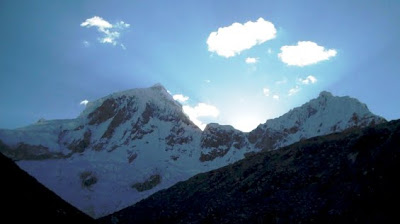
View from Base camp - Sunset on Huandoy
At Base Camp: Unfortunately, the burros driver was late and we have to wait for him at base camp with neither no warm clothe nor hot drink. Difficult situation to avoid to catch a cold ... We met 2 Mexicans at base camp, Israel and Alex. They know Hector, my climbing mentor. That night with Beto, Israel and Alex, we play cards with a Bob Marley music on the background. We had so much fun. We laugh so much. It felt really good, because it is this kind of moment which keeps alive the mountaineering spirit. We share hot drinks and food, then Israel and Alex went to bed as they will go to the Pisco Summit via the normal route in 5h. We finish our meal with high spirit, then we go to bed.
Tuesday, August 18, 2009
Day 2&3 - Acclimatization trek
Our acclimatization trek is a MUST DO! The landscape is beautiful.
Moday: We walked about 6 hours from 4100m to 4600m. We did a lunch break front of the Huatsan glacier and his beautiful dark blue lake with some icebergs floating. This glacier is very active, and avalanches very frequent. We slept front of this glacier, enjoying the alpine glow on the Huatsan massif. It is a really impressive massif. The night was not very cold. I am amazed that I did not even have a small headache due to the agrresive altitude gain.

video: 4600m panaramic view from our sleeping camp : http://www.youtube.com/watch?v=a0yHirQAzpk
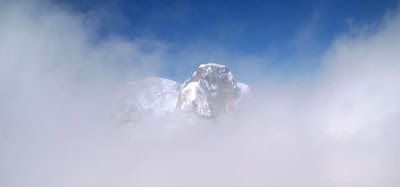
Tuesday: 7h of intense trek. We walked about 2h and reach the upper glacier lake of the Huatsan massif. The lake is turquoise, it is gorgeous ! To reach the pass, we have to go through a loose rocks section, then walked on the snow. The view at the pass is stunting. You are between 2 valleys and surrended by snow capped mountains. The pass is at 5000m, and I feel great. Then we went down, running in the scree, following by a short walk to another lake. This time the lake is green, due to copper and iron. We had our lunch there, then we went down the valley for few hours until 3800m to go up again to reach Churup base camp at 3960m. The last ascent part was tough. Long day ... but so beautiful
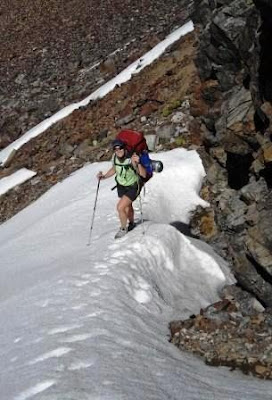
video: panoramic view from Huasan Pass : http://www.youtube.com/watch?v=qSHxJpu0bsw

Please note that this trek is not for beginners, it is for intermediate/expert due to:
- various types of terrain : mud, snow, scree, loose rocks, broken rocks ...
- it is pretty steep : angle between 30 to 45 almost all the way
- no trail : so you need to use the french step to ease the pressure on your ankles

